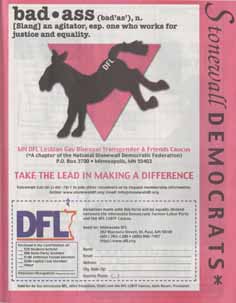Stonewall DFL
| Gay and Lesbian activists introduced their political agenda to Minnesota’s Democrat-Framer-Laborer party in 1972. Jack Baker—an activist involved with F.R.E.E., the first Twin Cities Pride Festival, and Baker Law Associates—convinced a group of queer men to join him at the University’s precinct caucuses.(1)
|

|
Allen Spear, the first openly-gay elected official in Minnesota History, used their platform to begin his 28-year career in politics.(5) They also convinced the St. Paul City Council to adopt gay rights ordinance—initially, the capital city seemed poised to become a national queer mecca.(6)
The Gay Right Caucus suffered course-altering setbacks in 1978; St. Paul voters repealed the city’s 4 year-old equal rights clause in 1978—the state DFL refused to adopt a pro gay ordinance the same year, as the nation’s political climate was changing. In 1980, the gay rights caucus decided to accommodate these changes and rethink its political strategy. The Gay and Lesbian caucus drafted its first constitution in 1980.(7) Two years, later, the DFL acknowledged and accepted the document, which has been edited several times since then.(8)
Presently, the Stonewall DFL is an active force to be reckoned with in Minnesota politics. The caucus supports and opposes bill proposals, political candidates, and delivers gay rights questionnaires to running candidates.
(1) Clendinen, Dudley and Nagourney, Adam. Out for Good: the Struggle to Build a Gay Rights Movement in America. New york: Touchstone Books, Page 227.
(2) Ibid.
(3) Ibid.
(4) Ibid.
(5) Ibid
(6) Ibid.
(7) http://www.stonewalldfl.org/constitution.htm
(8) Ibid.
Part of Minneapolis/St. Paul, MN: 100 Queer Places in Minnesota History, (1860-1969), (1969-2010)